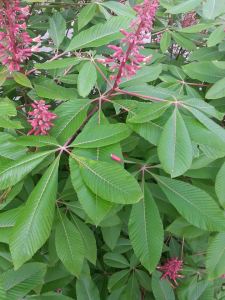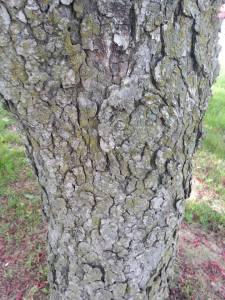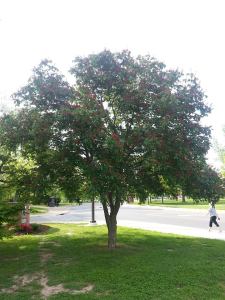A very low-growing tree or large shrub, Red Buckeye are aptly named for their showly flower clusters. The petioles of their leaves are also a dull red in contrast to their dark green leaves.
Aesculus pavia (Red Buckeye)
Family: Sapindaceae/Hippocastanaceae
Subspecies: var. pavia (red flowers), var. flavescens (yellow flowers), hybrid ‘Atrosanguinea’ (crimson flowers), hybrid ‘Alba’ (white flowers), ‘Humilis’ (low-growing), A. x carnea (cross between Red Buckeye and Common Horsechestnut (A. hippocastanum))
Hardiness Zones: 5-8 (possibly to 9)
Height: to 6 meters (20 feet) tall, rarely to 9 meters (30 feet) tall
Diameter: to 6 meters (20 feet) wide
Root System: Buckeye tend to have a woody taproot with lateral roots. Red Buckeye tend to have more fibrous root systems.
Growth Rate: moderate
Age: Flowering may begin in the second or third year after germination.
Deciduous: yes
Monoecious/dioecious: monoecious
Monocot/dicot: dicot
Tolerates: heavy/clay soils, drought (moderate), herbivores (deer), flooding (briefly)
Problems (major): leaf blotch, scorching leaves
Problems (minor): none
Poisonous: New shoots and stems, leaves, and seeds are toxic if ingested.
Soil requirements: prefers moist (average), fertile, neutral to acidic (pH 7.2 or less), well-drained soils
Air requirements: burnt in dry, arid environments
Watering requirement: moderate
Sun requirement: prefers partial shade, scorching occurs in dry conditions in full sun
Leaves: 5 (rarely 3 for new seedlings) leaflets, palmately compound, initially bronze to red or purple when developing, dark green when mature, red petiole with prominent midribs, minorly and finely serrated, elliptical, to 25 centimeters (10 inches) wide and long
Flowering structure: bright red panciles to 25 centimeters (10 inches) tall, individual flowers to 3 centimeters (1.5 inches) long, panicle upright, flowers narrow and tubular, pollinated by hummingbirds
Flowering frequency: April-May
Fruits: light-brown seed capsules, to 5 centimeters wide, globular contain 1-3 toxic fruits known as “buckeyes” maturing in autumn
Seeds require stratification: yes
Seed dispersal: gravity, water, rarely animal dispersion
Form: irregular, shrub-like
Trunk: typically singular, low-growing
Notable characteristics:
The panicles are bright red, showy, and attract hummingbirds. The early foliage is uniquely a mixture of bronze, red, and purple, maturing to a deep green. The seeds, unlike the Common Horse Chestnut, are toxic
Uses:
These are most commonly grown for their colorful inflorescences in early summer.
Sources used:
- http://www.missouribotanicalgarden.org/PlantFinder/PlantFinderDetails.aspx?kempercode=j210
- http://www.wildflower.org/plants/result.php?id_plant=AEPA
- http://plants.usda.gov/core/profile?symbol=AEPA
- http://www.floridata.com/ref/A/aesc_pav.cfm
- http://www.na.fs.fed.us/pubs/silvics_manual/volume_2/aesculus/glabra.htm
- http://www.illinoiswildflowers.info/trees/plants/oh_buckeye.htm
- http://www.oldhouseweb.com/gardening/the-msue-collection/aesculus-pavia-damask-horsechestnut.shtml
All of the images provided were taken by me. They may be used for educational/informational purposes only, provided that this article/online journal is appropriately cited first.




